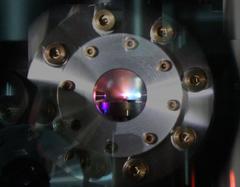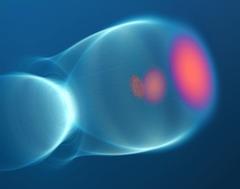URL: https://www.desy.de/news/news_search/index_eng.html
Breadcrumb Navigation
DESY News: Unique live view into plasma acceleration
News
News from the DESY research centre
Unique live view into plasma acceleration
An international research team led by DESY has for the first time accurately measured the acceleration process in a plasma without disturbing the process itself. The findings, now published by the group in the journal Physical Review Letters, open up a new possibility to understand the acceleration process in plasmas more precisely – a result that is key to developing this novel acceleration technology more quickly.

Light from the one millimetre long helium plasma in which the electrons were accelerated. Photo: DESY, Simon Bohlen
In order to precisely understand the process of laser-plasma acceleration, which lasts only a few femto- to picoseconds, it is essential to observe as precisely as possible how the properties of the accelerated particles change in the plasma. A team led by DESY researchers Simon Bohlen and Kristjan Põder has succeeded in doing just that in an experiment conducted as part of the BMBF Innovation Pool project PLASMED X. The PLASMED X project, led by DESY researcher Jens Osterhoff, aims to develop a compact laser-plasma-driven X-ray source for medical imaging. For their experiments, Bohlen and the team used the phenomenon of Thomson scattering, i.e. the scattering of light particles by electrons. They divided the laser beam usually used to accelerate the electrons into two parts. The team used one of these parts for electron acceleration. The other part was superimposed on the accelerated electrons in the plasma channel, so that the light could interact with electrons and be scattered by them. The researchers triggered this scattering process at 20 points in the plasma over a distance of 400 micrometres and used an X-ray detector to measure the energy of the photons that were scattered during these interactions. From these measurements, the team was able to reconstruct the energy evolution of the electrons over most of the accelerator length without disturbing either the electron beam or the acceleration process itself. Therefore, they were able to follow exactly at which point in the plasma cell the electrons were accelerated and how strongly.

Visualisation of the novel diagnostics: During acceleration in the tail wave of a high-power laser, electrons are scattered by a second laser in order to determine the electron energy. Image: DESY, Ángel Ferran Pousa
“Deepening our understanding of the acceleration processes in a plasma accelerator enabled by the beautiful method described in this PRL paper is key to advancing this important technology,” adds DESY´s Accelerator Division Director Wim Leemans.
“Congratulations to the team led by Simon Bohlen and Kris Põder. With the construction of the very stable PLASMED X plasma accelerator, they are setting the course for the future use of the technology as an X-ray source for medicine and for the development of innovative diagnostic methods,” says PLASMED X leader Jens Osterhoff.
The experiments involved researchers from DESY, the University of Hamburg, Queen´s University in Belfast and the Rutherford Appleton Laboratory in the UK.
Reference
In Situ Measurement of Electron Energy Evolution in a Laser-Plasma Accelerator; S. Bohlen, T. Brümmer, F. Grüner, C. A. Lindstrøm, M. Meisel, T. Staufer, M. J. V. Streeter, M. C. Veale, J. C. Wood, R. D’Arcy, K. Põder, and J. Osterhoff; Phys. Rev. Lett. 129, 244801, DOI: 10.1103/PhysRevLett.129.244801



